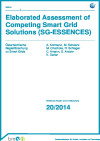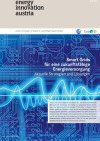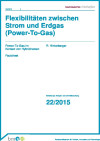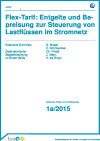Suchergebnisse
BIOGas - Einspeisung und Systemintegration in bestehende Gasnetze
Methoden der Einspeisung von Biogas in bestehende Gasnetze. Definition von Charakteristika für quantitative und qualitative Analysen. Aspekte der Systemintegration.
Upgrading of biogas for the gas distribution system of Salzburg
Development of a cost-effective cleaning unit, free of waste-products, for the upgrading of biogas to natural gas quality. Elaboration of the basis for a demonstration project injecting biogas into the gas distribution system of Salzburg.
Biogas als Treibstoff - Wirtschaftliche Grundlagen und Machbarkeit
Auf Basis der Analyse internationaler Best Practice Beispiele wurden die wirtschaftliche Machbarkeit der Erzeugung und Distribution von gereinigtem Biogas zur Verwendung als Treibstoff in Österreich untersucht und jene Arten von Versorgungssystemen identifiziert, die bereits unter den derzeitigen wirtschaftlichen Rahmenbedingungen wirtschaftlich umsetzbar sind.
Multifunktionale Energielösungen im Tourismus - Energiezentrale Alpendorf
Multifunktionale Energielösungen für die Tourismusregion Alpendorf: Maßnahmen zur Effizienzsteigerung, Einsatz erneuerbarer Energie, Organisaotrische Maßnahmen unter Berücksichtigung bestehender Kooperationen.
Elaborated Assessment of Competing Smart Grid Solutions (SG-ESSENCES)

Österreichische Begleitforschung zu Smart Grids
Schriftenreihe
20/2014
A. Kollmann, M. Schwarz, et al.
Herausgeber: BMVIT
Deutsch, 124 Seiten
Downloads zur Publikation
E_PROFIL - Quartiersprofile für optimierte energietechnische Transformationsprozesse
Mit E_PROFIL, als Methodenset zur Erstellung von Quartiersprofilen, wird ein wichtiger EDV-gestützter Werkzeugkasten geschaffen, der in der Planungspraxis österreichischer Städte zur Anwendung kommen wird, um eine energie- und ressourceneffiziente Stadtentwicklung zu unterstützen. Er ist ein wertvolles Asset für die Forschungs- und Planungsaktivitäten in Siedlungsverbänden.
RETRAIN - Training Network Renewable and Energy Efficiency Technologies in Buildings
The project aim on one hand is to evaluate and adapt current trainings in the field of biomass, solar thermal energy, photovoltaic, heat pumps and ventilation and on the other hand to define new potential trainings in case of further demand. This shall be a fundamental basis to prevent the threat of the absence of professionals and to increase the quality of already converted projects.
Wasserstoff aus erneuerbarer Energie in Österreich - Ein Energieträger der Zukunft?
Energiewirtschaftliche Optionen für die Erzeugung und Nutzung von Wasserstoff aus erneuerbarer Energie in Österreich mit Identifizierung von Vorzeigeprojekten, welche die Rolle von erneuerbarem Wasserstoff in einem energieeffizienten und flexiblen Energiesystem demonstrieren.
Smart Grids für eine zukunftsfähige Energieversorgung

Smart Grids für eine zukunftsfähige Energieversorgung - Aktuelle Strategien und Lösungen
energy innovation austria
2 /2016
Herausgeber: BMVIT und Klima- und Energiefonds
Deutsch, 8 Seiten
Downloads zur Publikation
Flexibilitäten zwischen Strom und Erdgas (Power-To-Gas)

Power-To-Gas im Kontext von Hybridnetzen (Factsheet)
Schriftenreihe
22/2015
R. Hinterberger
Herausgeber: BMVIT
Deutsch, 23 Seiten
Downloads zur Publikation
Renewable energy in Austria: Modelling possible development trends until 2020
The project investigates possible economic, social and environmental effects of a sustainable energy policy. Within a participatory modelling process a sustainability model is used to simulate different energy scenarios (with a focus on renewable energy technologies) for Austria until 2020.
Production of bioethanol in addition with heat, power and valuable byproducts
The production of bioethanol in Bruck/Leitha in addition to the production of heat, power and valuable by-products from biomass will be optimized by a new process simulation tool under the target of maximum usage of waste and low temperature heat and optimal source and product usage.
E_PROFIL - neighborhood profiles for optimized energy transformation processes
E_PROFIL is a set of methods (an IT-supported toolkit) for the elaboration of neighbourhood profiles. The aim of the project is to facilitate an energy and resource efficient development in the planning practice of Austrian cities. Furthermore, the project is an important asset for research and planning activities in Europe and can also be applied to other neighbourhoods.
CiQuSo - City Quarters with optimised solar hybrid heating and cooling systems
The project CiQuSo aimed to develop, evaluate and optimize concepts for solar energy systems to provide energy for buildings and cities. The applicability of the developed methods and concepts were shown as an example at Itzling, a part of Salzburg city.
PEAR - Prüfstand für energieeffiziente Automation und Regelung von Gebäuden
Der mit dem Planungsstand errechnete Energiebedarf deckt sich oft nicht mit den gemessenen Werten des Betriebs. In diesem Projekt werden Automation und Regelung auf den Prüfstand gestellt und eine Lösung zur Bewertung der Energieeffizienz von Regelstrategien in den Bereichen Raumlufttechnik, Betonkernaktivierung und Free Cooling entwickelt, welche anhand des Bauprojekts „Post am Rochus“ validiert wird.
Electrical peak load in supermarkets - Strategies to improve energy efficiency
Levelling and reduction of electrical peak load in supermarkets by using additional energy storage systems and by managing the consumption of industrial refrigeration facicilties. Techno - economic feasibility study with high potential of replications via involved industrial partners.
P2H-Pot: Potentiale, Wirtschaftlichkeit und Systemlösungen für Power-to-Heat
In P2H-Pot wurden die wettbewerbsfähigen Potentiale für Power-to-Heat (P2H) im urbanen Raum bestimmt. Mittels thermodynamischer Simulationen wurde die Eignung verschiedener technischer P2H Systemkonfigurationen untersucht und die Ergebnisse wurden mit Praxiserfahrungen aus Skandinavien kombiniert. Basierend auf einer Simulation des Strom- und Wärmemarktes in Deutschland und Österreich wurde die kurz, mittel- und langfristige Relevanz und Wirtschaftlichkeit von P2H analysiert. Gemeinsam mit einem Fernwärmeunternehmen wurden drei Fallstudien durchgeführt.
Indicators for urban areas – for construction, operation and mobility in climate-friendly areas
Development and coordination of indicators for energy and ecological evaluations of urban areas based on the Swiss 2000-Watt certification system. The results will be used for the development of a quality assurance system for urban areas similar to the klimaaktiv declaration for buildings and the e5 certification for communities.
solSPONGEhigh - Hohe solare Deckungsgrade durch thermisch aktivierte Bauteile im urbanen Umfeld
Im Forschungsprojekt solSPONGEhigh wurde die intensive Nutzung von thermisch aktivierten Bauteilen (TABs) als zusätzlicher thermischer Speicher in verschiedenen Gebäuden unter vorrangigem Einsatz von Solartechnologien (Solarthermie bzw. Photovoltaik) untersucht. Die Arbeitshypothese ging davon aus, dass durch die Aktivierung und Nutzung der bauteilimmanenten thermischen Speicher eine Deckung des Gebäudeenergiebedarfs mit Solartechnologien von bis zu 100 % erreicht werden könnte.
Flex-Tarif: Entgelte und Bepreisung zur Steuerung von Lastflüssen im Stromnetz

Schriftenreihe
1/2015
S. Moser, E. Schmautzer, Ch. Friedl, et al.
Herausgeber: BMVIT
Deutsch, 288 Seiten
